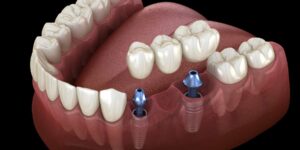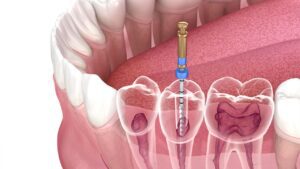Table of Contents
Dental crowns are caps that are affixed to broken teeth. Crowns are used to protect, cover, and restore the contour of your teeth when fillings are ineffective. Metals, porcelain, resin, and ceramics can all be used to create dental crowns. Over time, dental crowns need only regular oral hygiene and no extra maintenance.
Your teeth get damaged over time. There are many potential causes, including tooth decay, trauma, or simple wear and tear. Teeth can change in size or shape. Dental crowns are “caps” that fit over your teeth and have the shape of teeth. Imagine it as a snug-fitting cap for your tooth. The crown restores the original size, shape, strength, and look of your teeth.
The dental crowns are cemented on your tooth and cover the visible part of the tooth.
Why do you need a dental crown?
A tooth may need a dental crown for many different reasons. A usual response to this query is that a tooth requires a dental crown when the enamel stops serving its purpose since a dental crown replaces the enamel covering of a tooth. The strongest component in the human body, the enamel, is made to withstand the mechanical, chemical, and thermal stresses that food and drink place on our teeth. But unfortunately, it’s not invincible.
Enamel is prone to decay (cavities), acid erosion, and cracking. All of these can necessitate the use of the crown. The following are the most common causes for needing a crown to cover a tooth.
People who have lost teeth may find it difficult to smile or speak. Additionally, the inconsistencies in biting caused by tooth loss can negatively affect eating habits, resulting in secondary health issues, including malnutrition.
By replacing missing tooth roots, dental implants give people the power and stability to eat all the foods they enjoy without struggling to chew. Additionally, they improve face characteristics by stimulating and maintaining the jaw bone. Typically, when someone refers to “dental implants,” they mean both the implant (the false tooth root) and the prosthetic tooth.
Dental implant systems consist of an implant body, an abutment, and, in some cases, an abutment fixation screw. The dental implant body is surgically placed in the jawbone in the place of the lost tooth root. The abutment often protrudes through the gums to support the attached prosthetic teeth. It is fixed to the implant body with an abutment fixation screw.
Large Cavities:
Cavities result from bacterial infection of the enamel and other hard tissues that make up each tooth. The acid that bacteria make from eating sugar can break enamel and allow them to enter a tooth. The enamel is weakened and undermined when a cavity deepens, making it incapable of supporting proper chewing. To determine whether a tooth needs a filling or a dental crown, your dentist will assess the extent of the cavity and the amount of good tooth structure that is still there. In many instances, the cavity is so big that the tooth’s remaining structure can’t sustain a filling.
Large Fillings:
A dental crown may be required for a tooth if it already has a large filling. A filling can restore tooth structure lost to decay and is a superb restorative, but it does not provide strength to the teeth. It only plugs the hole. A crown may be required to protect a tooth if a filling is large and covers more than half of the exposed tooth to stop future decay.
Acid Erosion of Teeth
A considerable percentage of enamel is frequently lost through erosion in patients with severe acid reflux disease (GERD) or those with acidic habits (such as drinking sodas regularly). These teeth must be rebuilt, and a crown must replace the missing enamel to stop further damage and perhaps even the eventual loss of the tooth itself.
Enamel Loss from Heavy Grinding
Heavy clenching or grinding as you sleep can cause considerable mechanical wear and tear, leading to enamel loss. As the enamel gradually wears away, this causes the teeth become shorter and flatter. Rebuilding and covering damaged teeth with dental crowns help stop more harm and eventual tooth loss, much like acid erosion.
Cracked Teeth
While cracks can appear on otherwise healthy teeth, they are more prone to do so on teeth with big fillings. People who clench or grind their teeth at sleep may develop cracks in their back molars. They could also be the consequence of an accident, like biting onto a hard foreign object. A tooth’s enamel is disrupted when it cracks, allowing microorganisms and temperature sensations to enter the tooth. Cracks frequently cause cavities and sensitivity or chewing pressure.
Root Canal Treatment
A tooth with a root canal typically requires full coverage with a dental crown. This is due to the fact that root canal procedures destroy the nerves and blood supply in the internal hollow chamber of teeth. Teeth become fragile and very easy to break without a blood supply. Patients frequently fail to recognize the warning indications of a problem because teeth with root canal treatments, which also lack internal nerves, do not experience the symptoms of a broken tooth. Following a root canal procedure, the tooth requires a crown to protect it from breaking.
A crown may be used on the primary teeth in children to:
- Save a tooth that has suffered extreme decay and can no longer support a filling.
- Protect the teeth of children who are at high risk for tooth decay, especially if they have trouble maintaining their daily dental hygiene.
- Reduce the frequency of general anesthesia for kids who can’t fully cooperate with the demands of regular dental care due to their age, behavior, or medical history.
- A child’s dentist will probably suggest a stainless-steel crown in these situations.
What are dental crowns made up of?
Different materials can be used to make crowns. It is possible to use composite resin, ceramics, porcelain, porcelain fused to metal, or metal alloys. The tooth-colored material is frequently used while creating crowns to match your natural teeth.
Your crown should look natural and feel comfortable in your mouth. You and your dentist will consider multiple factors before choosing the material for your crown, including:
- The position and function of the teeth
- Placement of the gum tissue
- The number of teeth that are visible when you smile
- The tone or color of the adjacent teeth
Costs and insurance also play a role in selecting crowns for your teeth. You should discuss your preferences after you and your dentist have looked at these variables.
Benefits of dental crowns
Dental crowns help resolve many oral health issues. They are competent to:
- Support a tooth that has suffered severe decay.
- Keep a tooth that has already suffered damage from getting worse.
- Hold a tooth that is severely damaged or cracked together.
- Cover a dental implant
- Keep a tooth safe after root canal treatment.
- Change the color of a tooth to make it appear better
Compared to other dental restoration techniques or no treatment, dental crown therapy has a high success rate. Numerous scientific investigations that examined their use have supported this.
Are there any drawbacks of dental crowns?
Dental crowns have certain drawbacks, though, as the tooth must first be filed into the proper shape before the crown can be placed. This filing is frequently time-consuming and permanent.
Following the surgery, some individuals may feel uncomfortable, especially if they are sensitive to heat or cold. Another problem is discomfort or sensitivity when biting down, sometimes caused by an excessively high crown obstructing the teeth on the opposing jaw.
Crowns, especially porcelain ones, are susceptible to chipping on occasion. Small chips can usually be fixed without removing the crown, but bigger or significant breaks may need replacing the crown entirely.
The dental cement that holds the crown in place may wash away in certain people. As a result, the crown may break loose and permit bacteria to enter the tooth’s root, leading to tooth rot.
Rarely, porcelain or one of the metals used to create the crown may cause an allergic reaction.
The cost of dental crowns is typically higher than that of other direct tooth restorations, which may deter some patients from getting them.
Weighing the pros and cons
The advantages and disadvantages of a dental crown should be weighed for each patient to determine the best suggestion and course of action.
For example, a bridge with crowns is more durable than detachable partial dentures when replacing a missing tooth between two healthy adjacent teeth. Implants are generally considered a superior option to crowns because they do not impact the healthy surrounding teeth and there is a lesser risk of infection beneath the bridge.
Getting a dental implant might be the wiser choice if a patient can pay for one. Dental crowns with a bridge can be the best choice if the patient wants a strong but less expensive solution.
It is crucial to consider the purpose of the procedure while choosing the optimal course of action for the patient.
The procedure of getting a dental crown
Two visits to the dentist are typically necessary to prepare a tooth for a crown; the first visit involves cleaning, preparing and shaping the tooth, and the second involves placing the permanent crown.
The first visit
The tooth that will get the crown is evaluated and prepped during the first appointment. The tooth and the bone surrounding it are X-rayed. Your dentist may need to perform a root canal operation before placing the dental crown if there are any,
- Dental decay
- Damage to the pulp of the tooth
- Risk of infection
The tooth pulp is the soft tissue where blood vessels, nerves, and connective tissue are located.
The tooth that will receive a crown will have its top and sides filed down. This will free up room for the actual crown. The amount of tooth filling depends on the type of crown you get. Dental crowns made entirely of metal are thinner and less invasive than those made entirely of porcelain or porcelain fused to metal. If too much of your tooth is gone due to injury or decay, the filling material can be used to “build up” enough tooth structure for the crown to cover.
After the tooth has been reshaped, a paste or putty is used to create a tooth replica that will support the crown (also known as an imprint). Additionally, impressions will be taken of the teeth above and below the tooth that will get a dental crown. This process ensures that the crown won’t affect your bite.
The imprints are sent to a dental lab. The crowns are created in the laboratory and often delivered to the dentist’s office in two to three weeks. Your dentist will create a temporary crown during this initial appointment to cover and safeguard the prepared tooth while you wait for the permanent one.
The next visit
During the second appointment, the permanent crown is fixed to your tooth. First, the temporary crown is taken off, and the permanent crown’s fit and color are examined. If everything is in order, a local anesthetic (sometimes known as a “numbing” medication) may numb the tooth before the new crown is firmly affixed.
Same-day dental crowns
Dental crowns can also be created in the dental office if your dentist has the necessary tools. Similar to how a typical crown is constructed, this procedure begins with removing decay and shaping the tooth to ensure a flawless fit inside the crown. A scanning tool (a “wand”) is used during the same-day surgery to take digital photographs of the tooth within your mouth. The computer’s software uses these images to build a 3D model of the tooth. A second office machine uses the digital design to carve a ceramic block into the shape of the crown. CAD/CAM, often known as computer-aided design/computer-aided manufacturing, is used to create dental crowns. The crown is ready to be fixed into place in less than 15 minutes.
How long do dental crowns last?
A well-maintained dental crown lasts for 15 years on average. However, they frequently endure up to 25 to 30 years when properly cared for. The mouth is a complex system, and several factors, such as a person’s dental hygiene practices and daily wear a crown receives, can affect how long it lasts.
Maintain good oral hygiene habits, such as brushing your teeth at least twice a day, flossing every day, especially in the crown region where the gum meets the tooth, and gargling with an antibacterial mouthwash at least once a day.
How much do dental crowns cost?
The cost of crowns varies according to where you live and the kind of crown you choose (porcelain versus gold, for example). In general, crowns can cost anywhere between $800 and $1700 or more each. Insurance typically pays for a percentage of a crown’s price. Consult your dental insurance provider to get more details about the cost.

What issues might arise with a dental crown?
You could encounter some problems with your crown over time, such as:
Tooth Sensitivity
A newly-crowned tooth may experience discomfort or sensitivity immediately after the treatment as the anesthetic starts to wear off. You can feel some heat and cold sensitivity if the tooth covered by a crown still has a nerve. Your dentist could advise using toothpaste made for sensitive teeth when brushing your teeth. If you experience pain or sensitivity when biting down, the crown is likely too high on the tooth. Dial your dentist’s number if this is the case. This issue is simple to resolve.
Crown Chipping
Porcelain crowns occasionally break. Minor chips can be repaired, and the crown can be kept in your mouth. However, If the chip is significant or there are multiple chips, the dental crown might need to be replaced.
Loose crown
Occasionally, the cement holding the crown in place may wash out from beneath the crown. This not only makes the crown loose but also makes it possible for bacteria to enter and rot the remaining tooth. Reach out to your dentist if your crown feels unstable.
Crown falls off
Dental crowns have the potential to come off. When this occurs, it’s typically because of a bad fit or the lack of cement. If this happens, get in touch with your dentist right away. Before you can schedule an appointment, your dentist will give you detailed instructions on how to care for your tooth and crown. Your crown could be able to be re-cemented in place by the dentist. If the crown can’t be fixed, the dentist will advise getting a new one.
Allergic reaction
Dental crowns are frequently made of a combination of different metals, which can cause an allergic reaction. However, this is quite uncommon.
Dark line on crowned teeth
You might notice a dark line near the gum line of your crowned teeth. This is typical, especially if your crown is made of porcelain fused with metal. Simply said, the crown’s metal is visible through this black line.
What should you keep in mind before getting a dental crown?
Dental crowns are an effective long-term restorative procedure. That implies that you will have a crown in your mouth for a very long time. Of course, you want the most qualified and competent approach possible. Therefore, avoid going to the dentist without first assessing your options by comparing the types and costs of dental crowns. Consider every aspect before making a choice.
It could be preferable to invest a little extra and ensure that the benefits are positive and long-lasting. Selecting solely affordable options could result in subpar therapies, which would cost more, take longer, and cause more suffering in the long run.
Conclusion
Dental crowns are a safe and efficient technique to repair teeth and stop additional decay. If you are having difficulty chewing or have had a mouth injury, you should have a dentist examine you to determine whether you need a crown. A dental crown can restore and protect your natural tooth, giving you years of healthy chewing.
Whether you need a dental crown, an implant or just a regular cleaning, Quincy High Care Dentistry is glad to give you professional service that maintains the beauty of your smile. We pride ourselves on providing each patient with excellent care. Our team is here to assist you with any necessary dental treatment to keep excellent oral health for many years to come. Book an appointment here or call us at 617-405-4524.






